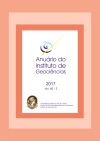Microtremor Response of a Mass Movement in Federal District of Brazil
DOI:
https://doi.org/10.11137/2017_3_212_221Keywords:
Seismic noise, Power Spectral Density, Probability Density Function, HVSR, f-k analysisAbstract
The present study provides a brief description of the ambient noise recorded at a slow moving mass movement in Ribeirão Contagem Basin. The area is an interesting natural laboratory as river detachment processes in a number of diferent stages can be identiied and are easily accessible. We investigate the site dynamic characteristics of the study area by recording ambient noise time-series at nine points, using portable nine three-component short period seismometers. The time-series are processed to give both horizontal to vertical spectral ratio (HVSR) curves as well as time-frequency plots of noise power spectral density (SPD). The HVSR curves illustrate and quantify aspects of site resonance efects due to the local geological setting. Probability density function (PDF) shows that noise level lies well between new high noise model (NHNM) and new lower noise model (NLNM) and their probabilities are higher above 2 Hz. HVSR curves present a uniform lithologically controlled peak at 2 Hz. Directional properties of the waveield are determined by beamforming method. The f-k analysis results in the E-W component show that at 5 Hz phase velocities are close to 1700 m/s while at 10 Hz dropped to 250 m/s. We observed that between 5 and 16 Hz the incoming waveield arrive from 260 degrees. Further studies will apply a detailed noise analysis for relating the dynamics of the landslide (which can be retriggered by river erosion as well as rainfalls and seismic shaking) to possible changes in detectable physical properties.Downloads
Download data is not yet available.
Downloads
Published
2019-07-30
How to Cite
Hussain, Y. (2019) “Microtremor Response of a Mass Movement in Federal District of Brazil”, Anuário do Instituto de Geociências. Rio de Janeiro, BR, 40(3), pp. 212–221. doi: 10.11137/2017_3_212_221.
Issue
Section
Article
License
This journal is licensed under a Creative Commons — Attribution 4.0 International — CC BY 4.0, which permits use, distribution and reproduction in any medium, provided the original work is properly cited.















